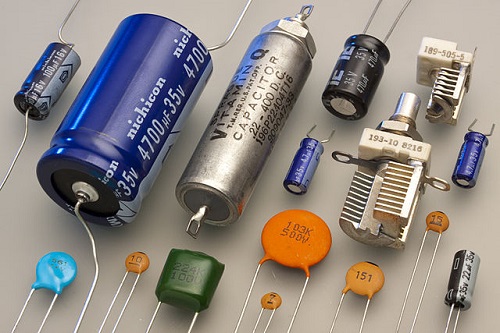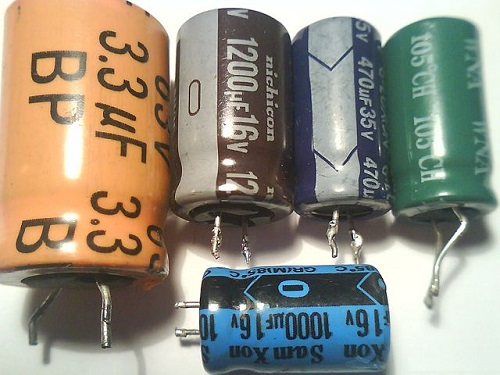Capacitors are passive electronic elements that can store electrical charge, but also omit the passage of AC through them. The capacitor consists of two or more conductors between which a different type of dielectric is placed. When there is a potential difference (voltage) between the two wires, a static electric field is generated which is separated from the dielectric by the positive and negative charges stored at the positive and negative pole of the capacitor respectively.
What is Capacitor?
The capacitor represents a system of at least two conductive bodies (plates, foils, metallized foils) separated by a dielectric, which has the ability to accumulate electricity. The classic electrostatic storage device for electrical charge consists of two parallel metal plates, separated by an electric isolator called a dielectric. The capacitance of the capacitor depends on the dielectric, so it is chosen according to the desired capacitance and the required size of the capacitor. The unit describing the capacitor is the capacity of the capacitor which shows the amount of charge Q a certain capacitor has on its metal plates at a certain voltage U. The characteristics of each capacitor alongside with its capacitance it is its operating voltage. The capacitance of the capacitor is higher if the active surface of the plates is larger, if there is less spacing and if the dielectric constant is greater between the plates. In order to get a higher capacitance of higher working voltage, the capacitors are connected in groups. The capacitors can be connected in parallel, tin series or in combination. Several capacitors connected in a group are called capacitors battery.According to the method of manufacture and the application, the capacitors can generally be divided into: electrostatic, electrolytic and electrochemical.
Application of capacitors
- Removing unwanted voltage surges in the power supply. By placing a capacitor of 0.01 to 0.1 mF between the ends of a voltage source that powers a digital circuit we are preventing the unwanted digital circuits.
- Refining the rectified AC voltage into a stable DC voltage. This is done by placing a capacitor 100 – 10000 mF between the output ends of the rectifier.
- Blocking of the DC signals and passing the AC signals.
- Carrying AC signals to the ground.
- Filtering unwanted parts of the AC signal.
- Integrating AC signal in the appropriate connection with the resistor.
- Differentiating AC signal in the appropriate connection with the resistor.
- Performing time functions.
Maintaining electrification to keep the transistor in turned on (open) or turned off (closed) state.
- Maintaining electrification to pass it through an electronic tube or light-emitting diode in form of a fast, strong impulse.
What is Condenser?
Condenser is a term used for a capacitor in the past. In time the term ceased to be used, with capacitor turning into the most commonly used term from 1926. Condenser and capacitor are one and the same viewed from electrical perspective. However in other fields of study, condenser may likewise allude to various different things. Condenser from mechanical perspective is additionally another name for consolidating vapor to water. Condenser as well means an optical system which focuses light beams from a light source into a narrower beam. Energy in capacitors is stored in the electric field, while in the case of condensers energy is stored in the electrostatic field (they work as heat capacitors). Condenser can represents a device that converts vaporous material (gas) into its fluid state. All condensers work on the principle of using a cooling system to remove the heat from the gas. Condensers are utilized as a part of thermal power plants, air conditioning systems, distilleries and so on.
Difference Between Capacitor and Condenser
1. Meaning of Capacitor and Condenser
The capacitor, in addition to the resistor and the coil is one of the three “passive” elements appearing in the electrical system. Generally, every system of two conducting bodies, regardless whether there is air or some dielectric between them is called a capacitor. Although for the most part there is no difference between the terms of capacitor and condenser, and the last is considered an abandoned expression regarding the same device, there are certain applications when condenser is used as a separate concept.
2. Use of Capacitor vs. Condenser
Capacitors have various applications – such as energy storage, filtering, rectifying, signal processing as motor starters etc. Condensers are used in air conditions or in optics.
Capacitor vs. Condenser : Comparison chart
Capacitor |
Condenser |
| Commonly used term for two conductive surfaces separated by insulating material | Rarely used term |
| The energy that is surrendered to the element turns into an electric field | The energy is turned into electrostatic field |
| Used for signal coupling, decoupling, filtering, motor starting, in computer memory applications etc. | Referred to gas into fluid convertor by heat removing or to optical system for beam focusing |
Summary Capacitor and Condenser
- Capacitors store static electricity and electric field energy that arises in the space between two electrically conductive bodies due to the separation of the electric charge. Given this diversity of their application they have many technical designs. They differ in terms of size, capacity, losses, breakthrough strength of the insulator, etc.
- When using a capacitor, two basic criteria should be taken into account – capacity and operating voltage. If we do not have a capacitor of sufficiently high capacity or its operating voltage is too low, then by joining more than one capacitor into the circuit we can get the required performances. This connection can be parallel, serial or combined.
- The term condenser is often used interchangeably with the term capacitor, although a lot less frequently in modern literature. However, sometimes it can denote different thing – like a device for converting vapor into water or a beam concentrating system.
- Difference Between Thermodynamics and Kinetics - June 24, 2018
- Difference Between Welding and Soldering - June 24, 2018
- Difference Between Additive Colors and Subtractive Colors - June 20, 2018




The clarification is very. Usefull for me.
Reply
In your opening statement, could you please change “AC” to “DC” as in “…omit the passage of AC through them.”?
Thanks,
Noji Ratzlaff
Reply
The statement “Energy in capacitors is stored in the electric field, while in the case of condensers energy is stored in the electrostatic field (they work as heat capacitors).” is nonsensical.
Reply